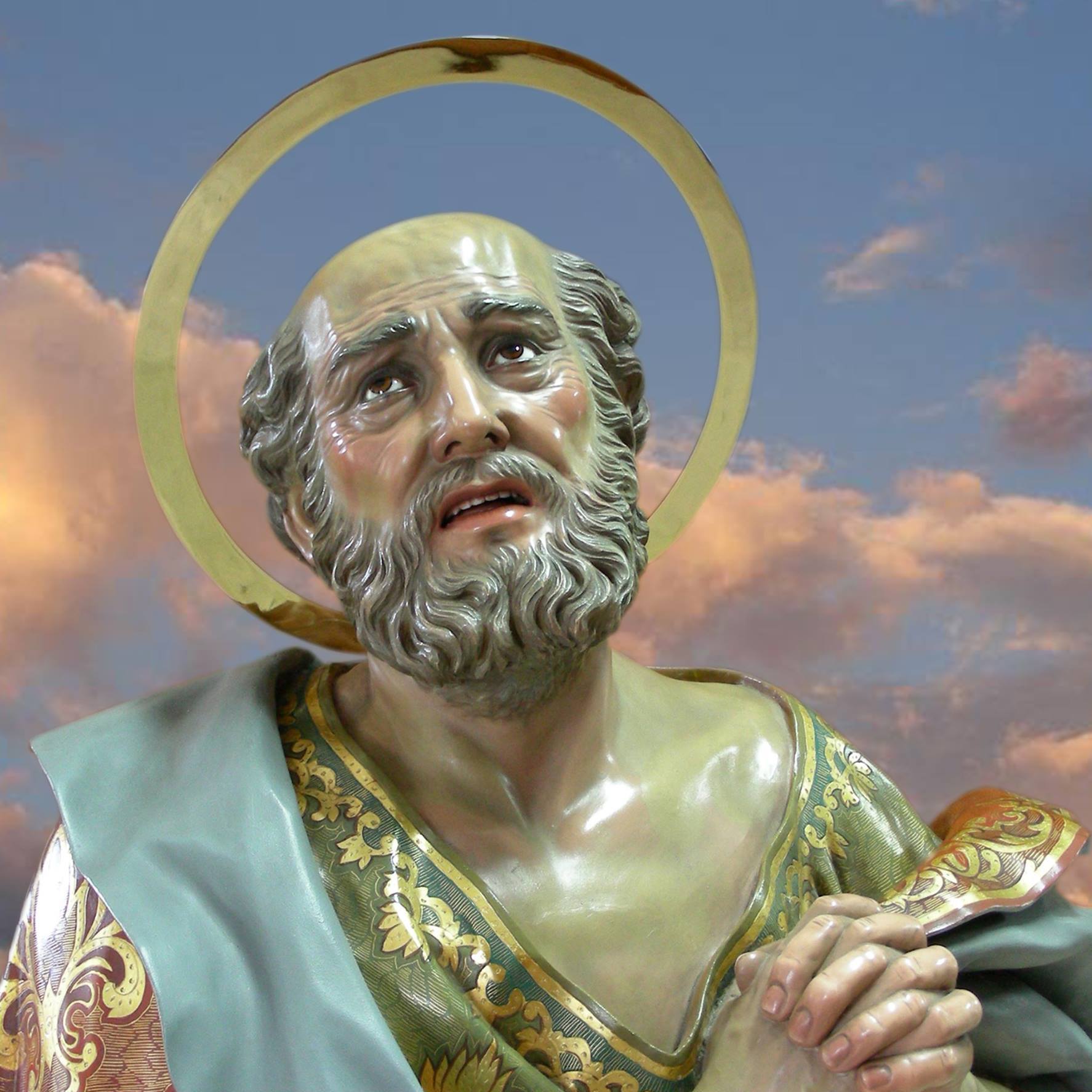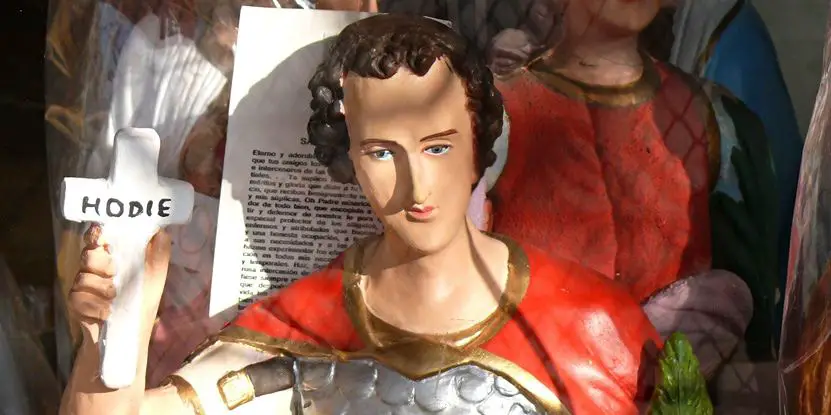St Peter the Apostle was one of the disciples of Jesus, perhaps the most beloved, follow our article and know the history of this saint.
St Peter the Apostle, also known as Simon Peter of Cephas, is considered to be the first pope. Despite his papacy, Peter had humble beginnings and became one of the Twelve Apostles of Jesus.
Biography and history of St Peter the Apostle
Peter was originally from Bethsaida, near Lake Tiberias, and was the son of Jonah. He and his brother Andrew were fishermen on Lake Gennesareth. The Bible tells us in Luke chapter 5 when the brothers met Jesus:
One day Jesus was standing by the lake of Gennesaret, with a crowd around him listening to the word of God, when he saw two boats on the shore. Fishermen had got out of their boats and were washing their nets.
He got into one of the boats, Simon’s, and asked him to pull it out a little way from the shore. Then he sat down and showed the crowd from the boat.
When he had finished speaking, he told Simon to go out into the deep water and cast his nets into the water to catch fish, to which Simon replied that they had been in the water all night and there were no fish, but he did as Jesus asked anyway.

Miraculously, they noticed so many fish that their nets began to tear, so they signalled to their companions in the other boat for help, and when they arrived they filled both boats to the sinking point.
When Simon saw what was happening, he knelt down and asked Jesus to leave him because he was a sinner. But Jesus said to Simon, ‘Do not be afraid; from now on you will catch these men. Then they took their boats ashore, left everything and followed him.
So Peter followed Jesus and his life was changed forever. Although he was one of the first disciples (see: Early Christian History) called to follow Jesus and eventually became the spokesman for the group, Peter is known for his “little faith”.
Jesus once told Peter to walk towards Jesus on the surface of the water. It wasn’t until he noticed the wind that he became afraid and cried out, “Lord… save me! Jesus touched him and said, “You have so little faith…why did you doubt? why did you doubt?”
This is one of many stories about Peter and Jesus. Another famous story is Peter’s attempt to rescue Jesus from the soldiers when he drew a sword and wounded the high priest’s servant, cutting off his right ear. The servant, named Malchus, was healed by Jesus before he was caught by the soldiers.
After the failed attempt to save Jesus, Peter is recorded as denying Jesus three times when Jesus was tried by the Jewish Sanhedrin.
After Jesus’ ascension, Peter presented himself as the undisputed head of the apostles, which is clearly described in the Book of Acts. He named the replacement for Judas Iscariot and was the first to speak to the crowds that had gathered after the descent of the Holy Spirit at Pentecost.
He was the first apostle to work miracles in the name of the Lord, and he judged the deceitful Ananias and Sapphira, who were robbing church members and God alike.
Peter was instrumental in taking the Gospel to the Gentiles. He baptised the pagan Roman Cornelius, and at the Council of Jerusalem he supported preaching to the Gentiles, enabling the new church to become universal.
King Herod had begun to persecute certain members of the Church and had beheaded John’s brother James. The Jewish community was grateful for the persecutions, so Herod continued and went after Peter.
After his escape, Peter resumed his apostolate in Jerusalem and his missionary efforts included trips to cities in the pagan world such as Antioch, Corinth and eventually Rome. From a variety of works it is certain that Peter died in Rome and that his martyrdom took place during the reign of the Emperor Nero, probably in 64 AD.
There are many accounts of his martyrdom, including those of Origen, Eusebius of Caesarea, Clement I of Rome, Ignatius and Irenaeus. According to tradition, Peter was crucified upside down on Vatican Hill because he was unworthy to die in the same way as the Lord. He was then buried in Rome near the Vatican.
In the early 4th century, Emperor Constatinus I (see: Constantine and the Catholic Church) honoured Peter with a great basilica on the site of his burial, despite the slope of Vatican Hill, which first had to be excavated.
In 665, according to a letter, Pope Vitalian sent the Anglo-Saxon Queen of Oswy, Queen of Northumbria, a cross with documents of Peter’s chains and unspecified relics of Peter.
In 1950 human bones were discovered under the altar of St Peter’s, and many claimed they belonged to Peter. In 1953, an excavation in Jerusalem found the tomb of Peter, whose former name was Simon, as well as the tombs of the other apostles, the Virgin Mary and Jesus.
In the 1960s, the discarded remains from the excavation under St Peter’s were re-examined and identified as the bones of a male human.
This discovery led Pope Paul VI to announce in 1968 that they probably belonged to the Apostle Peter. On 24 November 2013, Pope Francis unveiled the relics of nine bone fragments in public for the first time during a Mass in St Peter’s Square.
Watch this video to learn more about the importance of the Apostle Peter to the Catholic Church:
Prayer to the Apostle Peter
O glorious Saint Peter, who, in return for your strong and generous faith, your deep and sincere humility and your ardent love, was rewarded by Jesus Christ with unique privileges, and in particular with the leadership of the other Apostles and the primacy of the whole Church, of which you were made the foundation stone.
Obtain for us the grace of a living faith, not afraid to profess itself openly, in its entirety and in all its manifestations, even to the shedding of blood, if the occasion demands it, and to sacrifice life itself rather than surrender.
Grant us also a sincere loyalty to our Holy Mother the Church; grant that we may remain more closely and sincerely united to the Roman Pontiff, who is the heir of your faith and authority, the one true and visible Head of the Catholic Church (See: Who founded the Catholic Church), that mystical Ark outside of which there is no salvation.
Grant, moreover, that we may follow his teaching and counsel in all humility and meekness, and be obedient to all his commandments, that we may enjoy here on earth a peace that is sure and immutable, and that we may one day attain to eternal happiness in heaven. Amen.
Listen here to another prayer to the Apostle Peter, which is often recited:
Prayer to St Peter the Apostle for the collection of debts
You are the shepherd of the sheep, the prince of the apostles, to you were given the keys of the kingdom of heaven. You to whom Jesus said You are Peter, and upon this rock I will build my Church.
We beseech Thee, O Lord, through the apostolic assistance of blessed Peter, Thy Apostle, that the weaker we are, the more powerfully may we be helped by the strength of his intercession; that Thou mayest pray and intercede that I may be paid what is due to me, and thus, ever defended by the same holy Apostle, we may not yield to any iniquity, nor be overcome by any adversity. Through Christ, our Lord, amen.
The shadow of the Apostle Peter
The early days of the Church were a time of phenomenal growth and apostolic miracles. It is said that people took sick people out into the streets and laid them on mats so that at least the shadow of the apostle Peter would fall on some of them as he passed by.
Nowhere in the Bible does it say that anyone was actually healed by being in Peter’s shadow. Nor does it tell us that the apostles ever ordered people to line the streets or condoned such actions.
The only fact that the Bible tells us is that people obviously thought highly of Peter’s miracle and believed in the power of even his shadow.
People wanted to believe that there was something special about Peter, and they began to seek proximity to him in the hope that some power would pass over them. In Acts 3, one of the books of the Bible, God’s power was demonstrated through Peter and John when a lame man was healed.
The news spread quickly and a large crowd gathered in Solomon’s Colonnade in amazement.
The miracles performed by the apostles were demonstrations of the power and mercy of the Lord, confirming Christ Jesus as Saviour and testifying to the truth of His message.
See in this video the testimonies that speak of the shadow of the Apostle Peter as a miracle:
Day and feast of St Peter the Apostle
The feast of Saints Peter and Paul (see Saints Paul and Peter) is a liturgical feast in honour of the martyrdom of these apostles in Rome and is celebrated on 29 June. The feast is of ancient origin, this date being taken as the anniversary of their death or the transfer of their relics.
Peter is also honoured in the calendar of the Roman Catholic Church (See: Who founded the Roman Catholic Church). He is always associated with Paul. First chronologically, 18 January marks the feast of the Petri Chair (Latin: “Chair of Peter”) in Rome and 22 February in Antioch.
29 June is the Feast of Peter and Paul, one of the 12 most important feasts of the Roman Catholic Church. Peter’s escape from his chains is commemorated on 1 August. Finally, the feast of the Basilicas of Peter and Paul, which commemorates their construction by the Emperor Constantine, is celebrated on 18 November.
In this video we show you the life of Saints Peter and Paul:
Novena to St Peter the Apostle
O holy Apostle, for you are the rock on which Almighty God has built His Church; obtain for me, I beseech you, living faith, firm hope and ardent love; total detachment from myself, contempt for the world, patience in adversity, humility in prosperity.
I pray, purity of heart, right intention in all my labours, diligence in the discharge of the duties of my station in life, constancy in my resolutions, resignation to the will of God, perseverance in the grace of God until death; may it be so, through thy intercession and thy glorious merits.
May I be worthy to appear before the chief and eternal Shepherd of souls, Jesus Christ, who lives and reigns with the Father and the Holy Spirit for ever and ever. Amen.
Litany of the Apostle Peter
St. Peter, prince of the Apostles, St. Peter, to whom were given the keys of the kingdom of heaven, St. Peter, so ardent for the glory of Christ, St. Peter, whose heart was pierced by a single look from Jesus, St. Peter, who did not cease to weep because he denied the Son of God.
St. Peter, whose cheeks were furrowed by a stream of tears that flowed until the end of his life, St. Peter, who cried out: “Lord, you know that I love you”, St. Peter, who was bound in chains for Christ, St. Peter, who was freed from prison by an angel, St. Peter, who rejoiced to suffer for Christ.
St. Peter, whose shadow healed the sick, St. Peter, whose voice even the dead obeyed.
O glorious Apostle, who has received power to bind and to loose, pray for us, that we, free from all sin, may live and die in the grace of God. Obtain for us a perfect faith, a firm hope and an ardent charity, so that we may grow daily in the knowledge and love of Jesus Christ as we approach the end of our life.
Guide us, O blessed Apostle, through all the dangers of this exile, until fear and sorrow are over. O humble martyr of Christ, you who now see Him, not as Tabor, but in all the splendour of His glory, pray for us now and in death.
Come then, blessed apostle, and lead us to Jesus, that we may love him forever. Amen.
If you like, you can watch this video of the novena to St Peter the Apostle:
Sentences of the Apostle Peter
- “The salvation and perfection of man consists in doing the will of God, which he must keep in mind in all things and at every moment of his life.
- “Unless we have a passionate love for our Lord in the Blessed Sacrament, we will achieve nothing.
- “Our Lord said. Be yourself with the good Lord.
- “It is not your outward appearance that counts, but your inner disposition. Cultivate inner beauty, the gentle kind in which God delights.
- “Humble yourselves, therefore, under the mighty hand of God, that in due time He may exalt you, casting all your anxieties upon Him, for He cares for you. Be sober, be watchful. Your adversary, the devil, prowls around like a roaring lion, looking for someone to devour.
- “It is impossible for us not to talk about what we have seen and heard.
- “Live with passion and compassion, proceed with optimism, value disciplined thinking, be open to intimacy and love mystery.
- “God loves us beyond comprehension, and we cannot diminish God’s love for us.
- “But rejoice, because you share in the sufferings of Christ, so that when his glory is revealed you will also rejoice with great joy.
Knowing this first, that in the last days mockers will come, who walk according to their own lusts”.
Poems on St Peter the Apostle
O prince of the Apostolic Senate, herald of our Lord, first shepherd of the faithful, watch over the flock entrusted to you. Lead us through green pastures, nourish us with the food of the word, and lead us, thus nourished, to the heavenly fold, where you have already gone.
The shadow of your passing heals the sick, and Tabitha, who made clothes for the poor, rose at your will. Fettered in two chains, you were released by the power of an angel; he bids you put on your garments and your sandals, and behold, the prison door is open. To the unbegotten Father, and to the only begotten Son, and to the Spirit equal of both, be praise and supreme power of the King. Amen.
Watch this video to find out five fun facts about St Peter:
Basilica of St Peter the Apostle
St Peter’s Basilica in the Vatican is an Italian Renaissance building in Vatican City, the papal enclave within the city of Rome. Next in majesty is the Cathedral of St Paul Outside the Walls.
St. Peter’s Basilica in the Vatican is an Italian Renaissance building in Vatican City, the papal enclave within the city of Rome. Next in majesty is the Cathedral of St Paul Outside the Walls.
Designed primarily by Donato Bramante, Michelangelo, Carlo Maderno and Gian Lorenzo Bernini, St. Peter’s is the most famous work of Renaissance architecture and the largest church in the world. St Peter’s with visitors
It has been described as ‘unique in the Christian world’ and ‘the largest of all the churches of Christendom’.
St Peter’s is famous as a place of pilgrimage and for its liturgical functions. The Pope presides over a number of liturgies throughout the year, attracting audiences ranging from 15,000 to over 80,000, either inside the Basilica or in the adjacent St Peter’s Square.
St Peter’s has many historical associations, with the early Christian Church, the papacy, the Protestant Reformation (see: Who divided the Catholic Church) and the Catholic Counter-Reformation, and with many artists, notably Michelangelo.
As a work of architecture, it is considered the finest building of its time. St Peter’s is one of only four churches in the world to have the rank of Basilica Maggiore, all four of which are in Rome.
Tomb of St Peter the Apostle
According to Catholic tradition, St Peter’s Basilica is the burial place of St Peter the Apostle, one of the Apostles of Jesus and also the first Pope. St Peter’s tomb is said to be directly under the high altar of the basilica.
For this reason, all Popes have been buried in St Peter’s since the early Christian period, and there has always been a church on the site since the time of the Roman Emperor Constantine the Great. Construction of the current basilica, which was to replace the 4th century St Peter’s Basilica, began on 18 April 1506 and was completed on 18 November 1626.
In this interesting video we show you the tomb of St Peter and his remains:
Wonders of St Peter the Apostle
It is wonderful to think that the early Christians were given the power to work the same kind of miracles as their Master did when he lived on earth.
Peter now spent his life going from town to town, healing the sick and telling people about Jesus Christ.
A few miles from Jerusalem, in the town of Lydda, there was a man called Aeneas who had been paralysed in bed for eight years. Peter went to his house and said to him, “Aeneas, Jesus Christ makes you whole, get up and make your bed”. The man immediately got up and was healed.
Watch in this video the healing of the lame and sick man by St Peter:
Later in the city of Joppa there was a woman named Tabitha who was very rich and she was a seamstress, she made clothes for poor people, this woman suddenly fell ill and died, two men went to Lydda to get Peter and when Peter heard the news he knew that the Holy Spirit of Jesus was so powerful that he could raise the dead and he went to Joppa with the two men.
Peter took out the people who were in this woman’s room, knelt down and prayed to God and then said to her “Tabitha, get up”, the woman opened her eyes and sat up in bed, Peter smiled at her.
Film about St Peter the Apostle
There is a film called “San Pietro” (2005), directed by Giulio Base, which deals with the attitude of the first Christians (see: Who were the first Christians), and this is clearly reflected throughout the film, with honest effort and great faith on the part of the cast and crew.
It portrays the life of St Peter from the moment of Jesus’ crucifixion to the death of St Peter in Rome. This film is considered to be faithful to the historical facts and is considered to be a brilliant work of art.
It stars Omar Sharif as St Peter. He is great, with the twinkle in his eye that the real St Peter probably had, and shows the love for all people that the real St Peter learned from his Lord.
Omar Sharif is great and even if you are not religious you will love this film because of his performance. The rest of the cast are not so famous, but they give good performances too. I particularly liked Bianca Guaccero as the sweet young girl Silvia who is so in love with Claudio. These are Italian actors, among others, who are very good at playing Romans.




